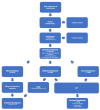Artificial Urinary Sphincters for Moderate Post-Prostatectomy Incontinence: Current Research and Proposed Approach
- PMID: 37760394
- PMCID: PMC10526785
- DOI: 10.3390/cancers15184424
Artificial Urinary Sphincters for Moderate Post-Prostatectomy Incontinence: Current Research and Proposed Approach
Abstract
Male urinary incontinence is a common complication after radical prostatectomy. The severity of incontinence can be assessed in various ways and helps determine the best surgical intervention to restore continence. While most patients with mild incontinence receive a sling and those with severe incontinence receive an artificial urinary sphincter (AUS), there are no clear guidelines on how to manage patients with moderate post-prostatectomy incontinence (PPI). Our discussion will focus on the current literature, which demonstrates that an AUS should be considered first-line in men with moderate PPI despite perceived concerns over complications and reintervention rates.
Keywords: artificial urinary sphincter; continence surgery; male sling; post-prostatectomy incontinence.
Conflict of interest statement
The authors declare no conflict of interest.
Figures
References
-
- Ficarra V., Novara G., Rosen R.C., Artibani W., Carroll P.R., Costello A., Menon M., Montorsi F., Patel V.R., Stolzenburg J.U., et al. Systematic review and meta-analysis of studies reporting urinary continence recovery after robot-assisted radical prostatectomy. Eur. Urol. 2012;62:405–417. doi: 10.1016/j.eururo.2012.05.045. - DOI - PubMed
Publication types
LinkOut - more resources
Full Text Sources


